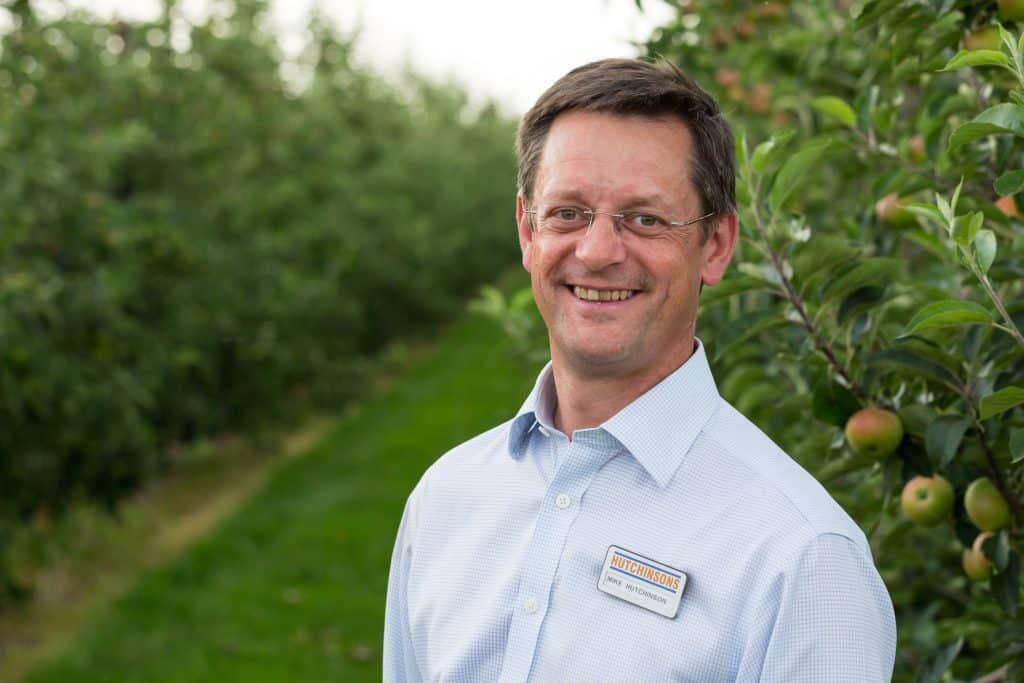Be tough on apple scab to safeguard chemistry – The Fruit Grower – Mike Hutchinson
Leading agronomy firm Hutchinsons is reinforcing the importance of maintaining a robust, proactive control programme for scab (Venturia inaequalis) in apple orchards this season ...
The firm has been working with NIAB EMR at East Malling in Kent to investigate factors that may have caused isolated scab issues experienced in 2020. This included testing disease samples to see whether any changes in the pathogen’s susceptibility to fungicides could have contributed to disease control not meeting the expected level.
Samples were collected from a selection of sites and analysed at East Malling. While results did indicate a slight sensitivity shift to some fungicide chemistry, Hutchinsons director Mike Hutchinson stresses it is nowhere near a level that will affect field performance.
“The NIAB EMR testing shows that some isolates did demonstrate a variability in sensitivity to certain chemistry compared with an untreated isolate, but it is at a level where there would not be any observable impact on efficacy from fungicides applied at the standard field rate.”

Mike Hutchinson, Horticulture director
Fungicide sensitivity testing in the laboratory deliberately uses actives at very low rates, typically 100 times lower than field rates, to help identify any slight shifts in sensitivity among isolates when benchmarked against a susceptible control sample, he explains.
“Failing to control scab may result from several factors including incorrect application time, poor spray coverage, applying products with the wrong mode of action in relation to the pathogen infection stage, and reduced sensitivities of scab strains to particular fungicides,” comments Professor Xiangming Xu, head of science at NIAB EMR.
This makes it difficult or nearly impossible to attribute control failure solely to an individual cause, he says. “Preliminary laboratory tests indicated that some strains from specific orchards may have reduced sensitivities to certain products when compared to baseline scab populations that have never been subjected to fungicides. Such reduced sensitivities are generally expected however the key question is whether such reduced sensitivities observed under lab conditions could have partially contributed to scab control failure in field conditions. To answer this question, further research is necessary on the development of scab on apple trees in the presence/absence of specific fungicides at the field applied rate.”
Mr Hutchinson says that the research highlights the importance of taking appropriate measures to safeguard existing fungicide chemistry for the future. This is especially important as the armoury available becomes more challenging, with fewer approved fungicides, tighter limits on application rates and extended harvest intervals. At the same time, modern varieties tend to be more susceptible to scab and have a longer growing season in which they need to be protected, he notes.
Most of the main fungicide groups including DMIs (triazoles), QoIs (strobilurins) and SDHIs, used within the horticulture and agriculture sectors are known to have the potential to develop resistance due to the nature of their activity, so effective stewardship must be employed at all times, he advises.
Stewardship measures include:
- Apply scab fungicides at robust rates to maximise protectant activity and avoid getting into a curative situation
- Maintain tight spray intervals, matched to conditions and disease risk – only extend intervals when the risk is very low
- Utilise disease forecasting and warning systems to help assess scab risk and accurately target spray applications
- Vary chemistry within tank mixes and throughout the spray programme to avoid putting undue pressure on any one chemical group or mode of action
- Ensure that spray applications are as accurate and efficient as possible to give products the best chance of working effectively. Correct water volume, air management, and forward speed can dramatically influence the quality of application
- Support chemistry with strong cultural scab controls, such as good orchard hygiene to reduce the risk of infection from inoculum overwintering on old leaf litter.
“We will continue to monitor the situation and respond appropriately to follow upon on our investigations,” Mr Hutchinson concludes.
Any growers concerned about the effectiveness of scab control should speak to their local Hutchinsons agronomist.